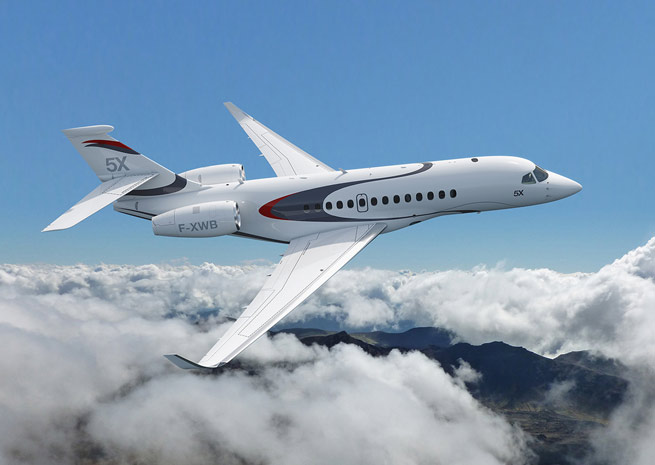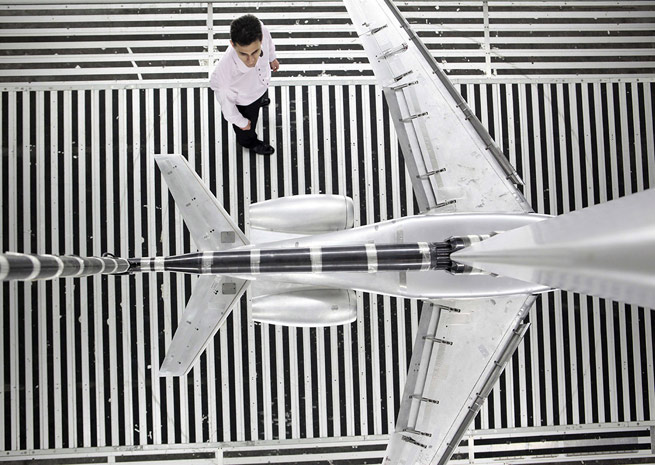
In perhaps the biggest—and most anticipated—story to come out of this year’s National Business Aviation Association (NBAA) convention, Dassault Aviation formally introduced its next business jet design, the Falcon 5X. The 5X, with its 5,200-nautical-mile range, Mach 0.90 maximum operating mach number (MMO), huge cabin, and advanced digital fly-by-wire control system, is aimed straight at Bombardier’s Global 5000 and Gulfstream’s G450.
Dassault’s senior vice president of civil aviation, Olivier Villa, outlined the main features of the new airplane, formerly known as the “SMS” (super mid-sized) within the Falcon Jet organization. First of all, the 5X fills the niche between Falcon’s existing 900LX and the company’s top-of-the-line 7X models. But its up to 16-passenger cabin with its six-foot, six-inch height; eight foot, six-inch width; and 38-foot, eight inch length closely rivals that of the 7X, and even exceeds it in the head room department by four inches.
The 5X will be powered by two Silvercrest Safran-Snecma turbofans of 11,450 pounds thrust apiece. Max takeoff weight will be 69,600 pounds—very close to the 7X’s 70,000 pounds. Engine maintenance and inspection intervals will be on condition, and the Silvercrests will be 15 percent more fuel efficient than any other engines in its class, Dassault said. This will allow a fuel savings worth $5 million over six years compared to the competition—based on 600 flight hours per year. Both the aircraft and the engines will benefit from real-time self-diagnosis via Snecma’s ForeVision monitoring system and Falcon’s FalconScan system, which checks more than 10,000 parameters simultaneously, diagnoses the root causes of any problems, and connects to on-board computing and reporting systems. Operating costs are advertised as being $2,700 per flight hour, with 45 percent of that represented by fuel burn.
Balanced field length was given as 5,250 feet and maximum operating altitude as 51,000 feet. Typical Vref airspeed will be 105 knots, although landing distances have yet to be posted.
A clean-sheet design, the 5X will employ a new wing with 33 degrees of sweep, a curved trailing edge, and flaperons that will enable steep approaches with optimal lift coefficients and without high airspeeds. The 5X’s new fly-by-wire system will also incorporate nosewheel and rudder steering during takeoffs. The airplane’s electrical system will automatically find and select the best redundant system to provide power in case of any failures, Dassault said.
The 5X will use the latest version of Honeywell’s Primus-Epic based system, which Dassault Falcon calls the EASy flight deck. But this time around, the airplane will have head-up displays (HUDs) created by Elbit Systems that merge both synthetic vision and enhanced vision (infrared) imagery in a combined vision setup—and available in a dual-HUD arrangement that can serve both pilot and co-pilot.
The 5X’s price is set at $45 million in 2013 dollars, its first flight should occur in the last quarter of 2015, certification is expected by the end of 2016, and deliveries will begin in 2017, Dassault said, adding that the first 30 airplanes had already been ordered with the dual-HUD cockpit.
With the 5X having specifications so close to that of the 7X, tongues are already wagging that the it is foreshadowing a glimpse of the future, when the 5X’s attributes could easily be applied to an ultra-long-range flagship—one that could give Bombardier’s Global 7000 and 8000, and Gulfstream’s G650, a run for their money. But for the near future, Falcon’s 5X team is more than content with redefining the super mid-sized category with what promises to be the most advanced business jet ever.



